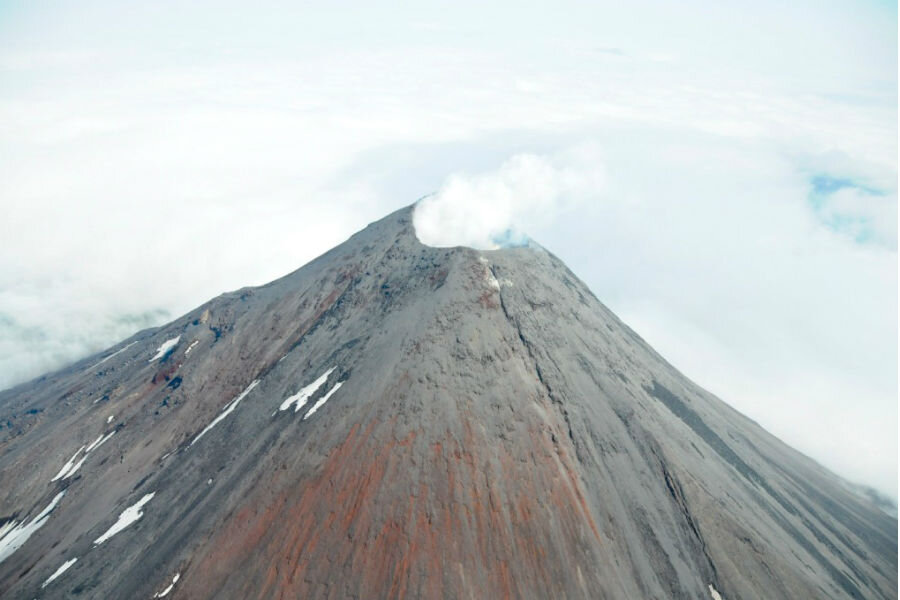When will a volcano erupt? Check for bubbles.
Loading...
Scientists studying Uturuncu, a dormant volcano in Bolivia, have discovered evidence that violent volcanic eruptions may owe their origins to incredibly water-rich magma, far below Earth's surface.
According to the researchers, who published their findings in the journal Earth and Planetary Science Letters, they started their search by analyzing rocks ejected by Uturuncu about 500,000 years ago. Scientists have known for a while about a density "anomaly" 15 kilometers (9.3 miles) underneath Uturuncu that slows seismic waves in the region and conducts electricity, unlike the ordinary magma that surrounds it.
So the researchers subjected the erupted rocks to the same pressure and heat that would be present underneath a volcano, and added various amounts of water until they could replicate the anomaly. The team found that if the rocks had an 8 to 10 percent water content, they matched the electrical properties of the subterranean anomaly.
From that, they calculated that enough water is hidden in these magma bodies that, if it could be chemically extracted, it would produce a lake "probably somewhere between Lake Superior and Lake Huron," said Jon Blundy, a researcher at the University of Bristol, UK and head of the project, reported New Scientist. "It's a staggeringly large amount."
Don't picture an actual underground lake. There's no body of water down there. Instead, the water molecules are bonded to different kinds of minerals, much like water is bonded to quartz to make an opal, a semi-precious gemstone. Nobody would attempt to drink an opal, but it would look very different if water weren't hidden in its chemistry.
Similarly, an enormous volume of water is bound up in the minerals of the magma underneath Uturuncu. That much water destabilizes the magma chamber beneath the volcano, say the researchers, which can lead to explosive results.
"Silicate melt can only dissolve water at high pressure; at lower pressure this water comes out of the solution and forms bubbles," explained Dr. Blundy.
In other words, as the magma rises toward the surface of the Earth, it is under less and less pressure. Once the magma gets high enough, the water escapes from its chemical bonds as high-pressure steam.
"Crucially – these bubbles can drive volcanic eruptions," he says.
Bubbles are pockets of gas escaping from a liquid, and anyone who has ever shaken a bottle of soda before opening it knows that even a small amount of escaping gas can force a lot of that liquid out in an unexpectedly violent way. On a geological scale, a volume of water the size of a Great Lake can provide enough bubble pressure for a massive explosive eruption.
For instance, this was the mechanism behind the 1980 Mount St. Helens eruption, the biggest eruption in the United States in recorded history. [Editor's note: This sentence has been updated for clarity.]
Similar water-rich magmas are likely responsible for volcanic activity at countless other subduction zone volcanoes, all around the Pacific Ocean's "Ring of Fire" and beyond.
The researchers hope that by better understanding Uturuncu they might be able to better predict when a catastrophic eruption will occur.
"This study illuminates a new feature of Earth’s deep-water cycle, and reminds us how little we know about the pathway of water through Earth’s crust and mantle systems on geologic timescales," Northwestern University geophysicist Steve Jacobsen told New Scientist.
Using similar techniques, in June his team discovered a volume of water, also dissolved in magma, that would be equal to three times the volume of Earth's oceans, about 700 km (435 miles) under Earth's surface.
Many scientists believe that much of Earth's water, in ice form or chemically bound to rocks, was delivered by comets in the early days of the Solar System. As more underground water is discovered, it supports the theory that Earth's oceans may owe much of their origin to underground processes.
"The process in Uturuncu is a microcosm of continental crust formation, and involves much more water than we thought, probably twice as much," said Blundy.








